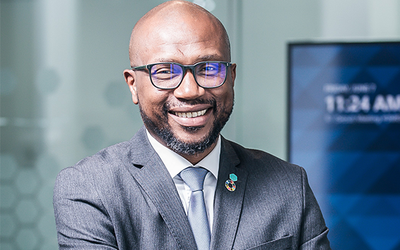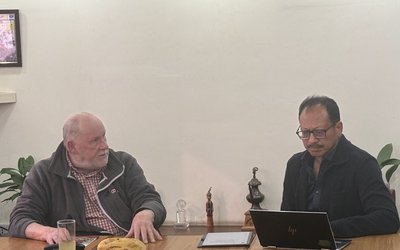Having worked in the Agricultural Development Bank for more than two decades, Pitambar Prasad Acharya realized that he wanted to do something on his own. Acharya, who was born in Rasuwa, developed a vision to uplift the life of the poor people. He launched a developmental organization called the Development Project Services Center (DEPROSC-Nepal) in 1993. Back then, nobody believed it would bring about a major change in the socio-economic life of the people in the remote parts of Nepal. In 18 years since, Acharya, the Executive Director of DEPROSC-Nepal, has shown that an NGO can actually make a real difference. His microfinance program has transformed many lives. Acharya recently spoke to New Spotlight on various issues.Excerpts:
How do you assess the role of microfinance programs in poverty alleviation?
Microfinance programs have made significant contribution to reduce poverty. One of the important things is that they are deeply rooted at the local level. This is one of the reasons why we could run our microfinance programs even during the ten years of violent insurgency. This shows that even conflict cannot disrupt programs supported by the people at the grassroots. Some analysts believed that remittances alone saved the country during the conflict. But that is not true. Actually, it was the microfinance that saved the country. Our microfinance program, for example, is providing services to more than 2 million poor people around the country.
Why is microfinance so effective?
Microfinance services have generated various kinds of employment opportunities. We give loans to the poor people who are without access to the banking sector due to its bureaucratic process and other requirements. Every loan investment has created around one and a half work day’s employment at the household level. We also provide better schemes than the bank’s provisions of loans and interests. Although banks say their annual interest rate is around 12 per cent, it will actually reach up to 25-30 per cent.
Why do you need the banks then?
We don’t have a huge amount of money but the banks have. We capitalize bank's money for the use of the poor people which otherwise would not reach to them as their delivery cost is and network do not support for it. DEPROSC is involved in microfinance business with 52,457 members covering 212 village development committees of 11 districts. We have 30 branches with 142 staff and 2,078 centers. Once the volume of this business increases, we need a robust regulatory framework to help sustain the program and let it grow further.
What is the state of your microfinance program?
Our microfinance has attained operational and financial self-sufficiency. We have disbursed over 5.25 billion rupees to the 50,000 women without the collateral and are maintaining over 99 per cent repayment. The internal savings generated from the rural women is around 260 million rupees.
How does microfinance work differently from the banks?
Microfinance institutions issue loans quickly, in less than a day, at affordable interest rates. A poor individual comes in the morning and gets the loan by the evening. This means the transaction cost will be less. Accessibility is important. The microfinance is right at the door step of the beneficiaries. This way the microfinance has been supporting poverty alleviation. When we provide Rs. 40,000 loan for a household, it creates an employment for ‘one to one and a half’ person. If you serve 50,000 people, you can generate 75,000 employment every day. This is a big thing. The banks are not into that.
How is the rate of return for your institution?
The payment is also satisfactory. Ninety-nine percent borrowers return the loans in time. This is not only with DEPROSC but with almost institutions working in microfinance sector. The return itself, however, not so high, our microfinance is self sustained. That is important in microfinance.
Are there any minuses of the microfinance program?
One of the negative sides of microfinance programs is that the institutions are expanded in Terai region only and it is yet to reach the doorsteps of the people in the hills and mountains . Actually, people living in the hills and mountains need microfinance facilities too. In Terai, there are enormous opportunities for transactions and people are enterprising. However, we are unable to establish microfinance in the hills where the activities are few and the people are very poor. Compared to the terai, the transaction cost in the hills and mountains will be much higher and microfinance cannot meet that cost. Here, the government’s role is important. Nepal government needs to create an enabling situation with both (i) Command and control and (ii) incentive strategies for the microfinance to work in the hills and mountains. The government levies taxes on microfinance institutions as much as it does to the commercial banks. Now every microfinance has to pay one third of the profit money as tax.
What do you think the government should do?
Our demand is that the government needs to return half of the tax collected from the profit of microfinance institutions to meet their deficits in the hills and mountains. If microfinance programs get some sort of incentives, they will also operate in the hills. The government need not dole out its money to benefit the poor people. In case the government agrees to give tax incentives; we will invest the profit made in the Terai as cross subsidies for the hills and mountains. At a time when 30-35 districts are yet to get the services from microfinance, the incentives given by the government in the profit tax will be used to open the more microfinance programs in all the districts. There is also the need to increase market accessibility in the hill so that microfinance institutions can reach all parts of Nepal, the hills, plains and the mountains.
How much money do you generate under the microfinance?
We have 52,000 clients and lenders. We generated 225 million rupees as savings. We also get Rs. 900 million loan from commercial banks to provide loan to marginalized groups. In total, we have over 1.12 billion rupees as outstanding. We provide loans to women only. We give vigorous training to them as to how they should mobilise funds.
In which areas, does your investment go mostly?
Particularly, 40 percent of our investment goes to the petty traders who visit mobile markets (hats in Terai), 30 percent of our loan goes to livestock and a small amount of money goes to agriculture. We invest money in fast returning areas like labor intensive programmes. Farmers are highly benefited from our programs.
It is said that you are starting your microfinance to work like a bank. What is the state?
We have DEPROSC Development Bank and the bank is performing satisfactorily. We have applied for a microfinance bank jointly with NABIL. We have our expertise in the rural areas and NABIL has expertise in banking. The name of proposed bank is NADEP and we registered an application for this at the Nepal Rastra Bank a year ago. The authorized and paid up capital of the bank is Rs. 320 million and Rs. 160 million respectively. DEPROSC and NABIL will have a share of 25 percent each with 10 percent by like minded organizations/persons and 10 percent by Lumbini Finance and Leasing Company mobilised into it.
When will it start?
We don’t know how long it will take to start. We are waiting for the permission from Nepal Rastra Bank.
Generally, how do you assess the role of NGOs in reducing poverty in the country?
NGOs have been playing an important role in reducing poverty. I think there is still the need of effective programs to reduce both absolute and relative poverty. For instance, DEPROSC has been working in six thematic areas. We have been working in micro finance, food security and sustainable livelihood, natural resource management, education, health, hygiene and nutrition, disaster risk reduction and emergency response and community infrastructure.
At a time when many people are expressing anger and frustration, how can your organization generate optimism and hope?
Every human being has different ways of thinking, positive as well as negative. In developing countries like Nepal, people’s perceptions are often negative. Even if some people do good works, the comments they receive are mostly negative. Negative comments discourage people. This kind of culture is there with us.
We have been making efforts to erase this kind of culture by launching development programs that generate concrete outcomes in the lives of rural poor. As per our understanding, the rural people actually demand development programs which will bring them tangible results, not just awareness. People know what they want. There is the need for a long term change to the negative thinking. Rural people are more positive and more aware than their urban brothers and sisters.
How many infrastructure projects has DEPROSC completed?
DEPROSC has already constructed more than 7,000 community infrastructure projects. We have constructed school buildings, health posts, drinking water projects, irrigation projects, and suspension bridges, chilling centres, marketing centres. We have constructed more than 20 bridges in Rukum and Rolpa districts and 30 in Nuwakot district. We need to implement programs keeping the poor people in mind.
How do you view the policies of the government in your context?
Nepal’s government policies to promote the private sector is very good in rhetoric, but it needs to translate them into practice. The government must think how the private sector can be made a good partner in the development process. The private sector is not a competitor of the government but a partner which can supplement the work of the government. Private sector, which is working to uplift the life of the poor people, should be taken as a partner not as a competitor. The work implemented by the private sector is much cheaper than the government’s work. We have been serving the people living in the rural parts of the country, where the government has less or no reach. We have been working in districts like Mugu, Kalikot, Humla and Dolpa of Karnali zone. These districts are very remote than Jumla itself. I feel proud to say that people living in such remote parts of the country know DEPROSC-Nepal. This is a major achievement. This is a lifetime gain.
Is your organization sustainable?
We are increasing our own internal resources and infrastructures to survive even without foreign support. If we establish our own institution, we can generate resources on our own. We are in the position to implement the programs on our own model. Despite negative publicity regarding the country’s development, something has been happening in the country. You can perceive the change once you go out of the capital. The development projects implemented in the districts do not have a broader implication and they are not visible. Had we completed many projects, they would have appeared before the eye of the people. I think it will take time to see the development but what I can say things are moving ahead.
How do you see the role of NGOS generally?
Our history of non-governmental organization is just a little over two decades old. Just after the change of 1990, non-governmental organizations were allowed to work rather freely in the country. Thanks to the openness policy, now we have 30,000 NGOs. I cannot claim that all of them are active and profound. Even if 1000 NGOs are active, they can bring a lot of changes. One must look at the NGOs contribution to GDP. I can claim that it is substantial.
Which sections of the population are you serving?
DEPROSC-Nepal has been actively working in 40 districts. We serve up to a million population. Our permanent program is microfinance. We have 300,000 people under this net. We have also been working with the World Food Program serving more than 50,000 households (300000 people). These people are living in a state of food insecurity. We have been providing them food to develop their own infrastructure. Under this scheme, people have been building rural infrastructure like schools, irrigation facilities, and roads. We don’t want to do just an eye wash under the food for work program. There is the need to transfer technology so that people increase their production. This way we can reduce their dependency on the food supplied from outside. There is also criticism against WFP programs. People argue that the food programs hampered the local products. The local products like wheat, barley and maize need to be promoted. There are a number of nutritional local foods. However, even Nepal Food Corporation has been supplying rice bought in plains. The criticism against the WFP is biased. We need to work more to improve the technology and encourage the local production.















